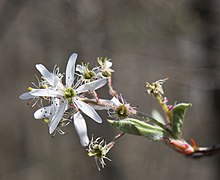| Amelanchier arborea | |
|---|---|

| |
| Scientific classification | |
| Kingdom: | Plantae |
| Clade: | Tracheophytes |
| Clade: | Angiosperms |
| Clade: | Eudicots |
| Clade: | Rosids |
| Order: | Rosales |
| Family: | Rosaceae |
| Genus: | Amelanchier |
| Species: | A. arborea
|
| Binomial name | |
| Amelanchier arborea | |

| |
| Natural range of Amelanchier arborea | |
| Synonyms[3] | |
| |
Amelanchier arborea (downy serviceberry[3] or common serviceberry[4]), is native to eastern North America from the Gulf Coast north to Thunder Bay in Ontario and Lake St. John in Quebec, and west to Texas and Minnesota.[3]
Other common names are "shadberries" (as their blossoming coincides with the shad runs in New England), "Juneberries" (because the berries usually set on in June), and "Service" or "Sarvice" berries because their blooms mean that the muddy back roads into the "coves and hollers" of Appalachia will soon be passable for circuit-riding preachers and the communities will be able to have Sunday services again. (Some say, more morbidly, that it means the ground is soft enough to dig, which means that those who died over winter can be buried and have services said over them.)[citation needed]
Amelanchier arborea is generally 5–12 m (16–39 ft) tall. Occasionally, it can grow up to 20 metres (66 ft) tall and reach into the overstory. The trunk can be up to 15 cm (6 in) in diameter (rarely to 40 cm or 16 in). The bark is smooth and gray.[5][6]
The buds are slender with a pointed tip, and usually more than two scales visible. The leaves are ovate or elliptical, 4–8 cm (1+1⁄2–3+1⁄4 in), rarely 10 cm (4 in), long and 2.5–4 cm (1–1+5⁄8 in) wide, with pointed tips and finely serrated margins. A characteristic useful for identification is that the young leaves emerge downy on the underside. The fall color is variable, from orange-yellow to pinkish or reddish.[5][6]

It has perfect flowers that are 15–25 mm (5⁄8–1 in) in diameter, with 5 petals, emerging during budbreak in early spring. The petals are white. Flowers are produced on pendulous racemes 3–5 cm (1+1⁄4–2 in) long with 4–10 flowers on each raceme. The flowers are pollinated by bees. The fruit is a reddish-purple pome, resembling a small apple in shape. They ripen in summer and are very popular with birds.[5][6][7] The fruit is eaten by over 40 species of birds and various mammals, including squirrels, rabbits, chipmunks, mice, voles, foxes, black bears, deer, and elk. [4]
It also commonly hybridizes with other species of Amelanchier,[6] the hybrid Amelanchier × grandiflora being one example,[8] and identification can be very difficult as a result.
- ^ IUCN SSC Global Tree Specialist Group.; Botanic Gardens Conservation International; et al. (BGCI) (2020). "Amelanchier arborea". IUCN Red List of Threatened Species. 2020: e.T144220543A152906152. doi:10.2305/IUCN.UK.2020-1.RLTS.T144220543A152906152.en. Retrieved 20 November 2021.
- ^ "NatureServe Explorer". Retrieved 2021-05-03.
- ^ a b c "Amelanchier arborea". Germplasm Resources Information Network. Agricultural Research Service, United States Department of Agriculture. Retrieved November 24, 2004.
- ^ a b USDA, NRCS (n.d.). "Amelanchier arborea". The PLANTS Database (plants.usda.gov). Greensboro, North Carolina: National Plant Data Team. Retrieved November 24, 2004.
- ^ a b c Tenaglia, Dan. "Amelanchier arborea page". Missouri Plants. Missouri Botanical Garden.
- ^ a b c d Amelanchier arborea. Trees of Wisconsin. Archived from the original on 2013-01-24. Retrieved 2006-04-01.
- ^ Bioimages: Amelanchier arborea images Archived 2012-02-04 at the Wayback Machine
- ^ "Amelanchier × grandiflora". Plant Finder. Missouri Botanical Garden. Retrieved February 13, 2015.

